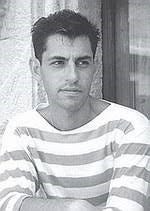An Art Memoir: Depth, Light, and Love

JUN 04, 2024
Salon Show at To Dentro
The next year, in 1996, To Dentro offered a salon show of The Exaltation Series and all their preliminary studies as work-in-progress project. The opening was accompanied by a presentation by art historian and archaeologist Thodoris Archontopoulos. One of the things he had to say was:
“Newberry works the human body like a surgeon’s intricate incisions. With the pencil or pastel drawings, we observe the immediacy of his observations of the subjects. These studies have sensuality because they start and end with his direct visual stimuli. His technical executions have been honed through personal experience, practice, and sensitivity.”
His complete presentation was revised as a review in the local newspaper, “The Rodiaki.”
114 Archaeologist and Art Historian, Thodoris Archontopoulos.
It was an honor that Thodoris and To Dentro would give a presentation of unfinished works; it felt like my new adoptive town fully embraced me living there. And it inspired me to work even harder to bring these major works to fruition. Though they would take a few more years to complete, I think it best to share them now with you.
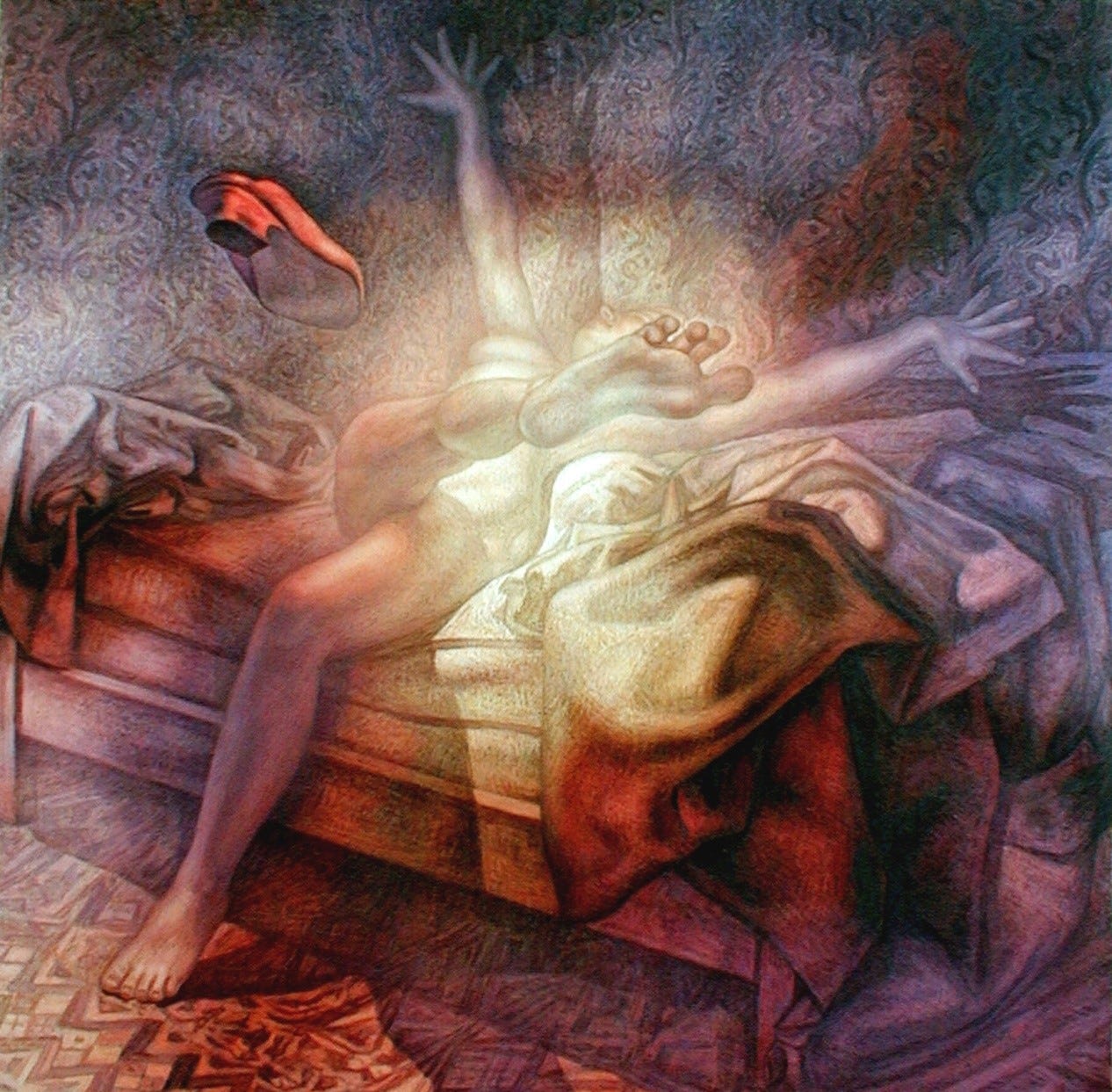
115 The Slipper, 1999, oil on linen, 46×46”.
The Slipper
A naked woman is kicking off a scarlet silk slipper that’s flying toward the viewer; a spotlight hits her torso, radiating lemony light outwards like a starburst, complementing her star-like pose, creating a sense of wild abandon and ecstatic energy. Her flinging foot, with its wiggling toes, is the focal point of the painting, backlit by the radiant glow. Her splayed fingers from both hands mirror each other; by flicking her wrists, she celebrates the inverse of jazz hands. Sheets and blankets are scattered around her like mountain peaks.
The highlights in the center of the canvas and on her torso are white, infused with a hint of lemon-yellow. As the light radiates outwards, it shifts to peach, pink, and then scarlet; at the furthest reaches, it turns a complementary cool purple. Her body is translucent, refracting and reflecting the surrounding colors. Every mark of paint denotes a color vibration placed to fit like a piece of a three-dimensional jigsaw puzzle.
Her symbolic, star-like pose reinforces the theme of bursting exuberance. Though I was not yet familiar with Aristotle’s eudaimonia, happiness as an end-in-itself, I explicitly aimed to paint a special moment that made life worth living (nearly an identical concept).
The model for The Slipper was Jonna Lee Pangburn. At the time she was a student of mine at Otis College of Art and Design, and would go on to be a very well-deserved Valedictorian. A decade earlier, in the eighties, she was a successful actress in movies and on television. Some of her most highlighted films include Chained Heat (1983), Making the Grade (1984), and Monster in the Closet (1986), where her performances showcased her versatility and talent. On television, she made notable appearances in popular series such as Another World (1983), Otherworld (1985), and Murder, She Wrote (1987-1990).
Jonna, as a student, was incredibly helpful for the students and teachers by constantly asking the teachers what was expected from the students. This raised the level of understanding and engagement: she helped unlock the teachers’ knowledge. Consequently, students got better grades, and the teachers taught better.
The Slipper is a beautiful and spontaneous expression of a joyous moment, a marvelous end-in-itself, yet held forever through the magic of art.
The Exaltation Series
The Slipper, The Gift, and Synergy were begun in Los Angeles in 1992 and finished late in 1999 in Rhodes, Greece. The series demanded a new way of conceiving figurative art for me—how to convey what exaltation felt like to me? It wasn’t simply a matter of expressing it through body language, or my use of light and color. I needed to project an out-of-body experience or create the sense of adjusting our human frequency to that of the universe. I did this by adding a third element to the painting: an abstract atmosphere with its complementary form of light, shadow, and color harmonies.
I had been listening intensely to Puccini’s operas, and how his orchestrations infused the whole opera with a unique atmosphere becoming a major player in the opera. For instance, his instrumentation for Turandot transports us to a mythical Chinese world. I saw my abstract atmosphere was to painting what Puccini’s orchestration was to music. My new concept was that there were three main elements: the body language of the figure, a supportive setting/backdrop, and lastly, the atmosphere that infused everything.
This use of the atmosphere created an unexpected problem: an abundance of transparency. With each of these paintings, as I was developing transparency over transparency over transparency, sometimes the area would dissipate into nothingness. An amusing perspective I had at the time was, “Hey Mom, I’ve been working on this painting for 7 years. Let me share it with you. Grab the painting by the back and turn it around to show a white canvas.” The experience did give me a better understanding of how abstract artists, thinking that abstraction was “the thing,” abandon all the other elements of painting, ultimately ending with a meaningless blotch of paint: showing how a good intention can turn into nihilism.
One great lesson I learned doing this series was that indeed, translucency is a magical part of painting, but it has to be integrated with other elements. I wasn’t wrong when I said translucency could lead to a white canvas. For translucency to work, it needs well-defined objects. This period is when I formed my theory about the axiomatic concepts of form, light, and space—the holy trinity. Still, it was a 7-year lesson, but I couldn’t be more proud of these amazing paintings.
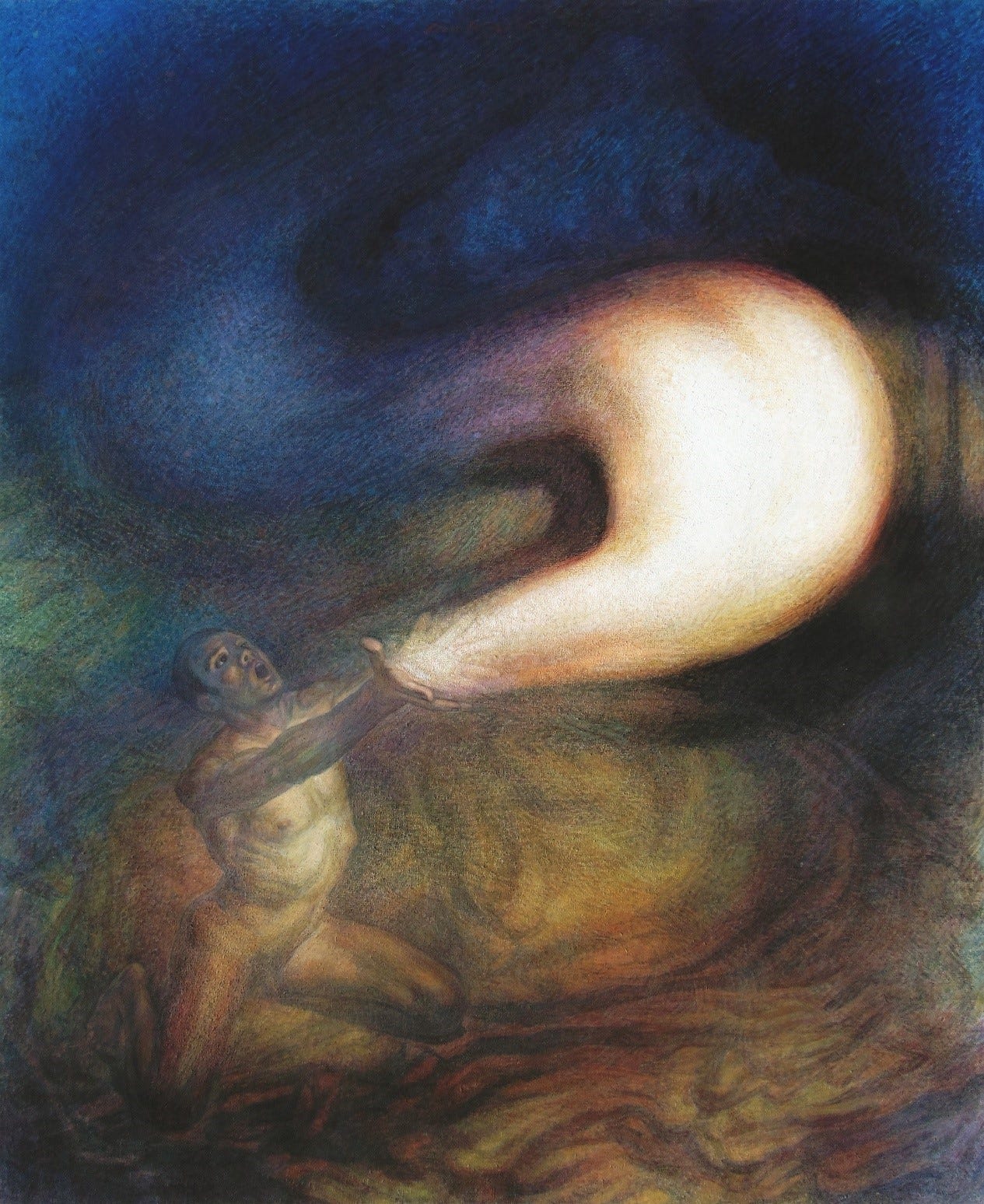
116 The Gift: Releasing Stars into the Universe, 1999, oil on linen, 84 x 66”.
The Gift: Releasing Stars into the Universe
The lower body of a naked man is drawing energy from the Earth, then cycling it through his being, releasing it as radiant light that shoots out of his hands in a gesture of offering. He is a vessel for the transfer of the universe’s energy. He is on his knees on a rocky ledge at the bottom left, slightly turned away from us. The light releases on an upward diagonal, banking in the foreground, then curves as it winds its way, receding into space.
The colors shift from warm ochres, oranges, and earthy greens in the lower foreground to shadowy purples, blues, and blacks in the upper background. His body takes on the same colors as the rocky earth around him, while the lightest areas are reserved for the splendor of white light gently molded by warm yellows and oranges.
His expression is one of awe at the rapturous force he is releasing.
The model for this was an Argentinian singer and performer. He brought an incredible energy and focus to posing for it, fully embracing the concept. I clearly remember how hypnotized he was, seeing refracting glints of light on his hands—he gave me the feeling that he was actually holding stars in his hands.
The Gift reflects what it feels like when I am painting or drawing: that I am absorbing the vibration and energy around me, channeling it, then actively turning that energy into art. Consequently, the artwork takes on a life of its own as it ventures out into the world. Pablo Picasso names that feeling perfectly:
“The meaning of life is to find your gift. The purpose of life is to give it away.”
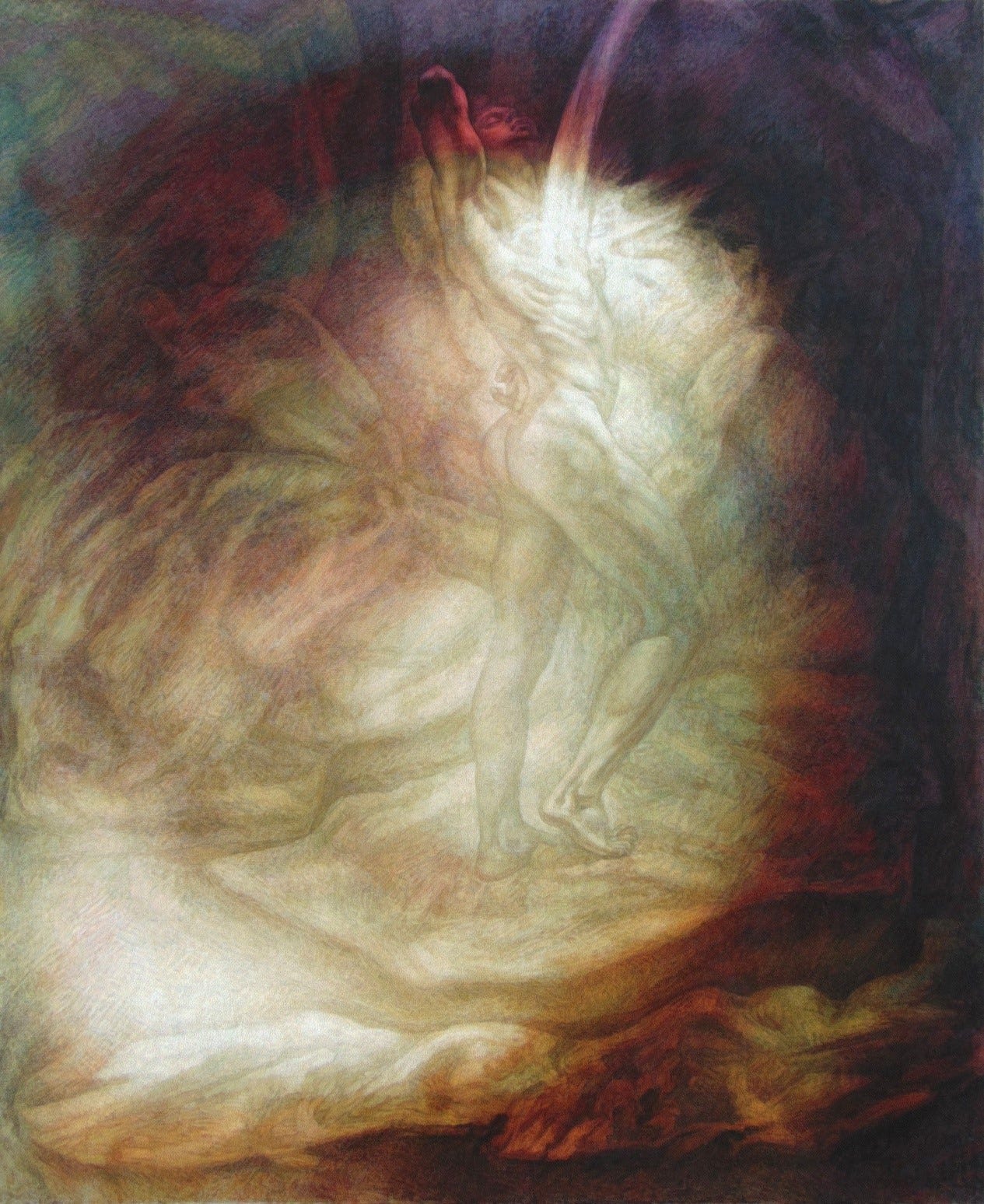
117 Synergy, 1999, oil on linen, 84 x 66”.
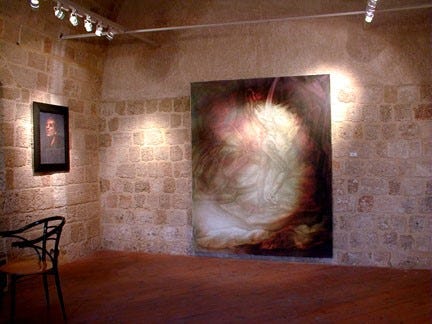
118 Synergy exhibited at Motor I, The New Museum of Contemporary Greek Art, Rhodes, Greece. (2002)
Synergy
Similar to The Gift and The Slipper, yet in a distinct way, the naked man in Synergy draws energy from the Universe but doesn’t project it; he’s immersed in it, as if radiance has found its home within him. The spout of water hitting his chest comes from the same direction as the light source—these elements, water and light, merge together to create a synergistic experience. His body is positioned on the canvas slightly above and to the right of center, as if rising to meet the splendor.
An atmosphere of colorful light and shadow pervades the scene. The light currents of white, gold, pink, green, and orange are framed by the darker counter-current of black, purple, and dark red, with an interesting harmony of purple and green in the furthest distance in the upper left-hand corner. Most of his transparent body is in the light current, while his arm and head take on the dark red reflective light of the shadows. His left hand behind his back has his index finger pointing downwards, back towards Earth. It’s my little symbolic gesture that all this glorious exultation is to be found on Earth.
The model for this had posed for one of my life drawing classes at Otis College of Art and Design. He was originally from Paris and moonlighted as a guitar player for a band doing Hollywood gigs. The graphite drawing study of him took 6 sessions lasting 3 hours each. At the time, it was either pay for the model or delay my rent—an artist’s occupational hazard. I remember our first session; I spent 3 hours simply lining up the landmarks of his body through triangulation, like a star chart. And when everything lines up, then I would be able to connect the masses with relative freedom. The resulting harmony of the forms creates beauty, which is nearly impossible to do without that initial math.
Because I needed to use spotlights for this painting, he came to pose at night. One of the lights was attached to the loft’s sprinkler pipes, directing it down at him. Then I set up a soft, indirect light from the lower left, directed up against his back, legs, butt, and back. I had a third light on my drawing; for the rest, the loft was in darkness. When I started to draw his forms and their lights and shadows, he could clearly see his reflection in the glass-covered large drawing opposite him. Momentarily, he was surprised and said, “God, I look like that?!” It inspired me that this good-looking guy had zero vanity, and consequently, he gave a wonderful sense of authenticity to the figure.
Synergy represents for me the interconnectedness that surrounds and flows through us all. It’s a feeling I often experience while creating art, or simply walking anywhere, where all my senses are heightened and fully engaged in absorbing energy.
An Epic and Painful Failure
The preceding trio had a companion piece, The Pond, which I worked on as long as the other three. The Pond shared a similar quality of absorption with Synergy. It depicted a reclining man on a rocky bank by a river, dipping his finger into the water. The scene conveyed a sense of pure enjoyment in a beautiful setting. All the individual studies for the painting were truly beautiful: the figure, the clothes, the background, the rocks, the pond itself, and the atmospheric sketch. I loved them all, but I couldn’t find a way to integrate them into a cohesive and successful final painting. The Pond ended up with countless layers of paint, almost becoming three-dimensional. Yet, paradoxically, everything seemed to be dissolving within the layers. This exemplifies that focusing solely on transparency ultimately dissolves the image, leading to a nihilistic dead end.
There was a deciding moment when I realized that the composition should have originally been horizontal and not vertical. Then I said to myself, “That’s it. I’m done.” Though it wasn’t a spontaneous choice, and I don’t regret it. I just wish I had had the goods to make the painting successful. Stoically, I got a box cutter and shredded the painting. It was a very painful moment psychologically to destroy seven years of work; it felt like I had engaged in some ridiculous undertaking, almost like a heavily invested affair that goes south. In my heart, I knew I had exhausted all efforts to fix it, and I could no longer continue trying. I didn’t cry or anything, but I still feel a wistful sadness that I couldn’t make it work. Even decades later, I’ve considered revising it as a new work.
There’s a little background to why I shredded it. Years earlier, when I was living in the East Village, I had thrown away a really bad painting. I had put it in the trash can in front of our building and went out to do some shopping or was coming back from a life drawing session. I was horrified to see that some vagrant had gone through the trash, found the painting, and then hung it up on the outside of the building to display it. I was mortified. At that moment, I realized that if I’m going to throw away a painting, I must destroy it, or it will come back to haunt me.
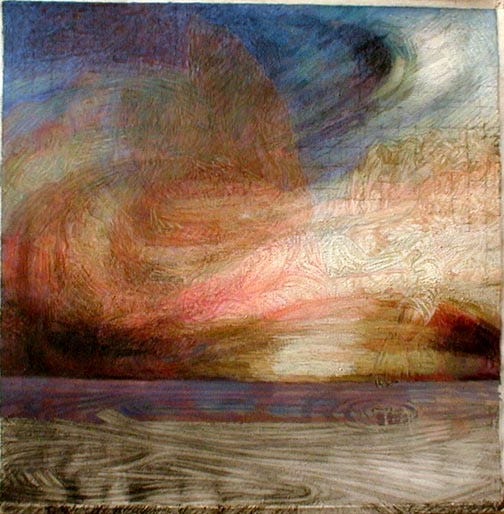
119 The Pond, wip, (destroyed).
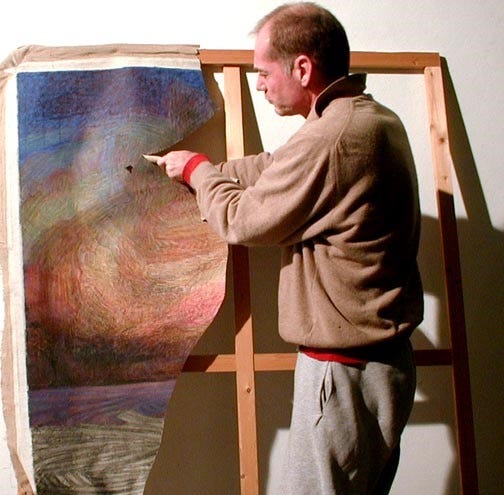
120 Me shredding The Pond with a box cutter, 2000.
From the Death of One Painting to the Birth of Another
Luckily for my artistic health, as I was destroying The Pond, I had begun work on what would be one of my greatest works, Icarus Landing.
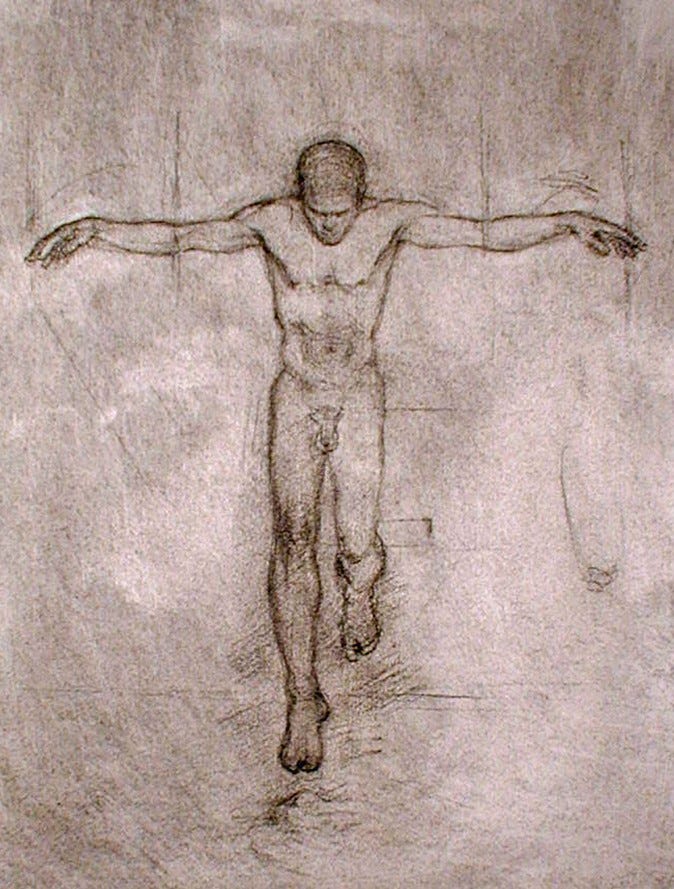
121 Charcoal study for Icarus Landing, 1999.
Published on My Substack
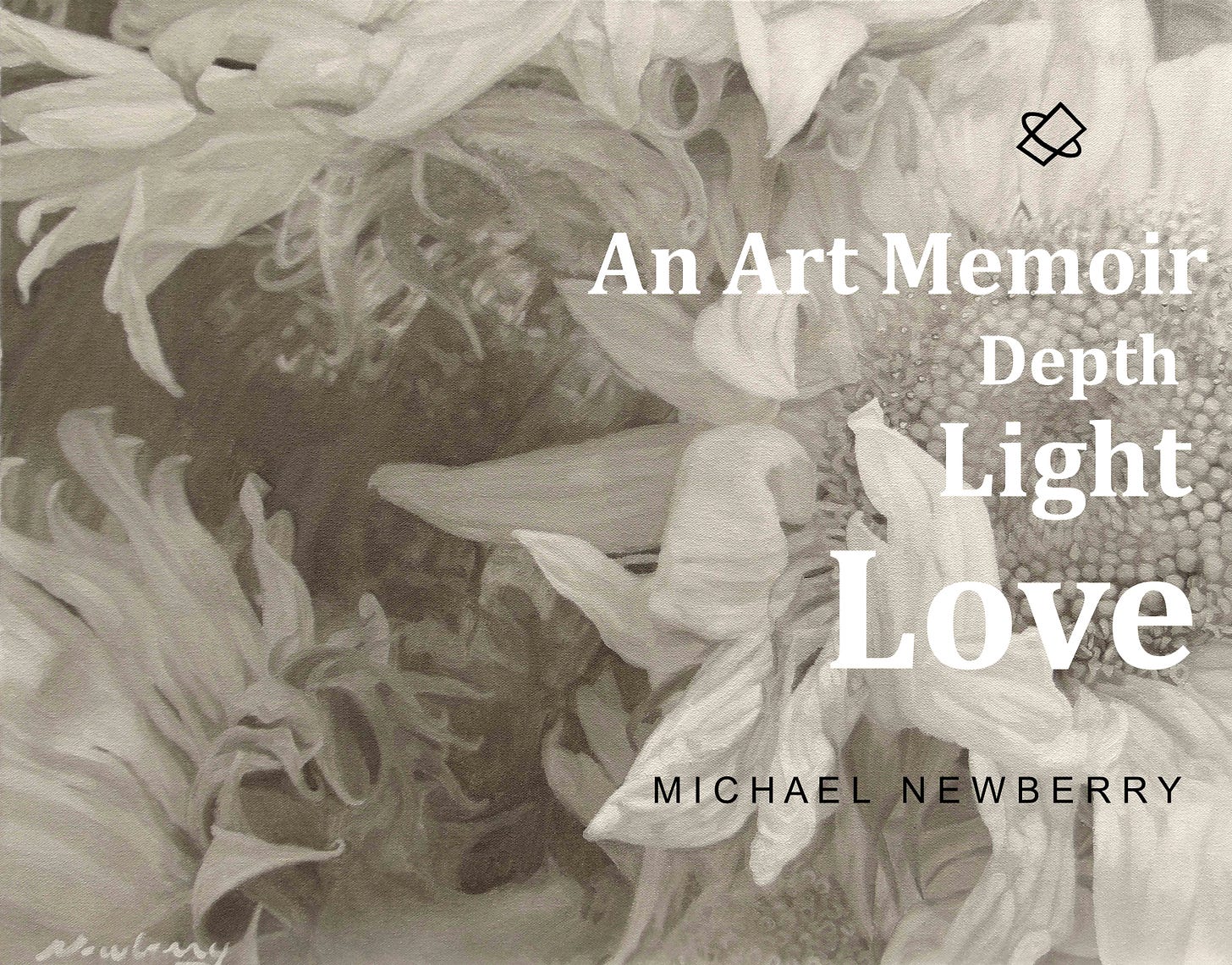
Release maybe in the Fall 2024. Posting the chapters here as I write them. : )



